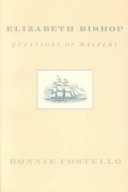A profoundly visual poet, Elizabeth Bishop has a prismatic way of seeing. In this companion to the poetry, Bonnie Costello gives a sense of Bishop and her ways of seeing and writing. Drawing on Bishop's unpublished writings - her journals, letters, and manuscripts - to reinforce her interpretations of the poems, Costello demonstrates that Bishop's work portrays both the desire for personal and artistic mastery and the dangers and illusions to which such desire is prone. Costello focuses particularly on Bishop's optical strategies and the images she employs to manipulate the normative, revealing much about the poet's attitudes toward space, time, art, and memory. She shows how Bishop's use of multiple and unusual perspectives was influenced by surrealist and symbolist art (partilcularly the work of de Chirico, Klee, and Ernst); how she turns away from devotional and Modernist attitudes toward mutability in an effort to "refect nature's own violation of static form"; and the extent to which Bishop "views memory as a thread of life, a dynamic principle of limited continuity in a world of discontinuities". This book is a critique of Bishop's vision and poetics.
Costello's readings of Bishop's work, together with her re-evaluation of Bishop's visual qualities, add a new dimension while providing a guide for scholars, students and general readers.
- ISBN10 0674246896
- ISBN13 9780674246898
- Publish Date 21 October 1991
- Publish Status Active
- Out of Print 14 August 1996
- Publish Country US
- Imprint Harvard University Press
- Format Hardcover
- Pages 278
- Language English
